
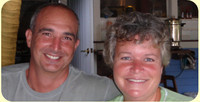
- PHOTOS:
- Dec 16, 2008 - May 21, 2009
- Mar 17, 2008 - Dec 15, 2008
- Nov 01, 2007 - Mar 16, 2008
- Our SC35 Sailboat: PRUDENCE
- SELECTED BLOGS
- Jan'05: The Idea
- May'05: First Cruise - Belize
- Aug'05: Buying Ashiya
- Oct'05: School in St. Vincent
- Nov'05: Ocracoke on Ashiya
- Jul'06: Long Trip on Ashiya
- Oct'06: Prudence Comes Home
- Nov'07: First Night Offshore
- Nov'07: Offshore Take Two
- Nov'07: Gulf Stream Crossing
- Dec'07: Green Turtle Cay
- Dec'07: Lynyard Cay
- Dec'07: Warderick Wells Cay
- Jan'08: George Town
- Jan'08: Life without a Fridge
- Jan'08: Mayaguana Island
- Jan'08: Turks & Caicos
- Jan'08: Dominican Republic
- Jan'08: Down the Waterfalls
- Feb'08: Puerto Rico
- Feb'08: Starter Troubles
- Feb'08: Vieques
- Mar'08: Finally Sailing Again
- Mar'08: Trip So Far
- Mar'08: Hiking Culebra
- Mar'08: Kayak & Snorkel I
- Mar'08: Teak and Waterspouts
- Mar'08: Kayak & Snorkel II
- Mar'08: Bottom Cleaning
- Apr'08: Culebra Social Life
- Apr'08: Culebra Routine
- Apr'08: Culebra Beaches
- Apr'08: Culebrita
- Jun'08: Kayak & Snorkel III
- Jun'08: Kayak & Snorkel IV
- Jun'08: Manta Ray
- Jun'08: Sea Turtles
- Jul'08: Cost of Cruising
- Jul'08: Busy Week in Culebra
- Jul'08: Getting to Land
- Jul'08: Leatherback Boil
- Jul'08: Fish and Volcano Dust
- Aug'08: Teaching Algebra
- Sep'08: Culebra Card Club
- Oct'08: Kayak & Snorkel V
- Oct'08: Prep for Hurricane
- Oct'08: Hurricane Omar
- Oct'08: Fish and Sea Glass
- Oct'08: Waterspouts
- Dec'08: Hurricane Season Ends
- Dec'08: Culebra to St. Martin
- Jan'09: Antigua Part 1
- Feb'09: The Saints
- Feb'09: Visiting Dominica
- Mar'09: Antigua Part 2
- Apr'09: Antigua to Bermuda
- May'09: Bermuda to Norfolk
- FULL LIST of Blog Entries
15 July 2009
14 July 2009
15 June 2009
14 June 2009 | Annapolis, MD
13 June 2009
12 June 2009
11 June 2009
10 June 2009 | Little Creek Marina, Norfolk, VA, USA
04 June 2009 | Little Creek Marina, Norfolk, VA, USA
31 May 2009 | Little Creek Marina, Norfolk, VA, USA
29 May 2009 | Little Creek Marina, Norfolk, VA, USA
26 May 2009 | Little Creek Marina, Norfolk, VA, USA
25 May 2009 | Little Creek Marina, Norfolk, VA, USA
13 May 2009 | through 21-May-2009
13 May 2009 | through 21-May-2009
12 May 2009 | St George's Town, Bermuda
11 May 2009 | St George's Town, Bermuda
07 May 2009 | St George's Town, Bermuda
04 May 2009 | St George's Town, Bermuda
21 April 2009 | through 02-May-2009
The Good and the Bad of Dominica
28 February 2009 | Portsmouth, Dominica
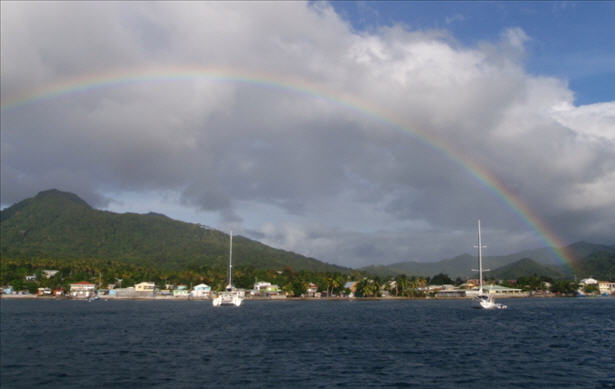
CURRENT LOCATION: Anchored in Prince Rupert Bay, off the town of Portsmouth, Dominica
15 34.671' N, 061 27.622' W
So far, we are enjoying our time in Dominica, but as with any place or circumstance there is both the GOOD and the BAD to consider:
Let's start with our anchorage. For the first two days we were here, the winds blew strong and gave us a good test of the set of our anchor. It passed the test with flying colors. On Day 1 I dove on the anchor, and on Day 2 Sheryl dove to the 20 ft mark and confirmed that the anchor was still solidly planted in the sand. The anchorage is incredibly large, so boats tend to keep their distance from one another. This allows us the additional comfort to have out excess scope. When anchoring with chain rode, the excepted minimum scope is 4:1. We dropped the anchor in 20 feet of water, and we always add 5 feet from the water line to the bow roller, so a 4:1 scope on 25 feet is 100 feet of rode. Here I felt comfortable letting out additional scope, especially since we plan to do a few days of land-based touring. We currently sit securely with 175 feet of chain in the water, a nice safe scope of 7:1, and a firmly set oversized anchor. (GOOD)
During those first two days the breeze through the boat was wonderful, the distance to shore kept any real chop from developing, and the anchorage seemed very well protected from any ocean swell. Conditions have changed over these last two days. The tradewinds moderated, and we are sitting in the wind shadow of some very high mountains. The calm has allowed the boat to drift around, and it invariably finds the swell. Whereas before our stern was pointed directly out to sea, we now lie beam-to the opening of the bay and the rolling motion has begun, once again. The motion was significant enough last night to send me to my lee-cloth cocoon in the salon. (BAD)
As an added potential hindrance to the goal of obtaining a good night's sleep, the people of Dominica like their nighttime music and they like it loud. Fortunately, on the first night of our arrival we discovered that we were just far enough away from Big Pappa's place to easily endure the background noise. It also helped that the winds were blowing strong and the now common noises generated as the wind moves through our rigging tended to further dampen the musical intrusion. We both said that this was nothing compared to the nocturnal auditory disturbances we had experienced while in Puerto Rico. (GOOD)
Last night the quality of the assault changed considerably. First, a second source of music was added to the mix. We are located closer to the 'disco' than to Big Pappa's. Last night, for the first time since our arrival, the disco was in full swing. Their musical selections alone would not have been too bad to listen to (mostly 70's music we knew all too well). However, these melodies were not alone. The reggae music generated from Big Pappa's mixed poorly with the disco tunes and created a discordant noise that made our ears wince. In addition, the calmer conditions allowed this cacophony to be delivered to us in crystal-clear high-fidelity sound. Finally, it should be noted that the common practice for nighttime music here appears to be as follows: Start the tunes at a modest volume around sunset, then turn the volume up one notch at the top of each hour, and continue this process until the volume dial reaches 11. The music, at maximum volume, then continues without break until 5AM. I wonder when these people sleep? (BAD)
I spend so much time discussing our conditions in the anchorage because that is where we have spent the bulk of our time. For a variety of reasons, we have elected not to inflate our dinghy here. We are well-stocked in the food and water departments, the two dinghy docks along the shore are both short and suffer from breaking swell, and we have reached a region of the Caribbean where it is prudent to lift your dinghy from the water each night (for security reasons). It is easier to simply leave little Patience stowed below. Fortunately, for us, any land-based needs we have can be coordinated through our Indian River Guide, Alexis. (GOOD)
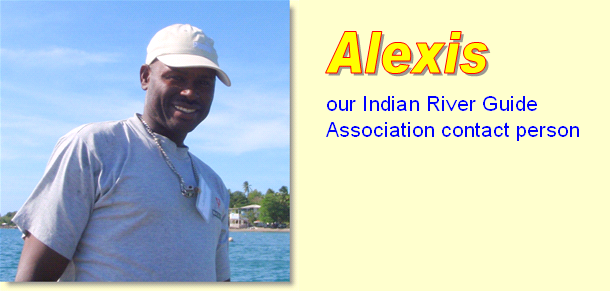
The only disadvantage to being without our own tender is a slightly diminished social capacity. Recently, we have had several folks swing by and compliment the looks of our boat. Some are sailboat connoisseurs and can correctly identify it as a Southern Cross on sight, others inquire as to the make of our vessel. Another line of conversation is often opened by passersby who take note of our hailing port: Oriental, NC. We debated for some time when we were faced with the decision of selecting a hailing port. In our hearts we hail from Whortonsville, the place where we took the dream of cruising and converted it into a reality. Unfortunately, we probably would not have started nearly as many conversations with other cruisers had we listed our port as Whortonsville. Oriental is recognized by many due to its location along the ICW and its dedication to representing itself as the Sailing Capitol of North Carolina. In any case, our brief conversations with others as they pass by en route to anchor their boats is just that, brief. There isn't much chance for social follow-up when we are not taking our own dinghy to and from shore, which often opens the opportunity for the casual drop-by visits which often result in new friends. (BAD)
Yesterday, I finally stepped off the boat and onto land for the first time since Sunday. Alexis had approached us with the offer of coordinating a guided tour, and we accepted. The main goal of the tour was to see two parrot species which live only in Dominica, the sisserou and the jaco. In order to increase our chances of spotting these birds, we needed to get an early start. At 6AM, Alexis arrived to pick us up. Before we reached the dock Alexis had also gathered our still sleepy-eyed companions on this tour: Peter & Catharina (s/v Victoria W) and Geoffrey & Dave (s/v Anam Cara). We were delivered into the capable hands and minivan of our tour guide for the morning, Andy. One of the highlights of the day was the opportunity to socialize with others. (GOOD)
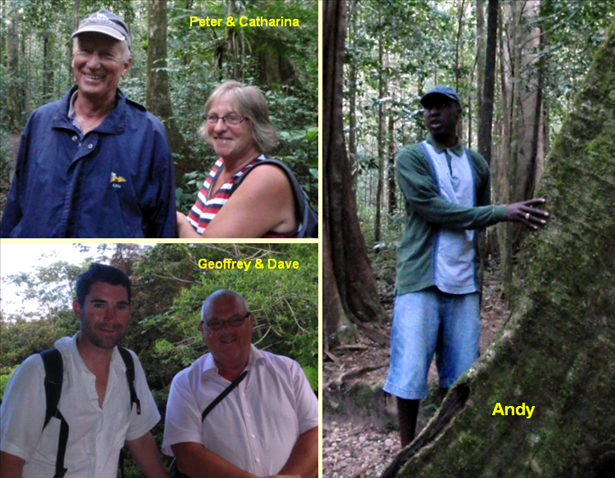
We bounced along in the minivan for about 20 minutes before reaching the Syndicate Rainforest. Once there, we took a leisurely stroll on a trail which was only about a mile long. No parrots were to be seen, although they taunted us with their calls from up high in the tree-tops. From there we climbed back into the van and made a short trip to the trail leading to Milton Falls. This trail led through someone's private land, then crossed a stream several times before arriving at the falls. While others in our tour were helped through each stream crossing by Andy, balancing precariously on slippery rocks in an effort to keep their shoes dry, Sheryl and I marched right through the water in our Keens (recommended footwear for any wet/dry outdoor experience). The falls turned out to be a bit disappointing. The natural spectacle was awe inspiring, as any waterfall tends to be; however, since the waterfall is a source of drinking water for villages below, a large fence (topped with barbed wire) had been erected around the pool at the waterfall's base in order to discourage swimming (Apparently the multiple signs indicating serious consequences for violating the no swim policy were not enough). It was an eyesore on an otherwise beautiful locale. Then it was back in the minivan for a bouncy ride back to the dock. The round-trip tour lasted less than 4 and a half hours. The cost to us was considerable: $40 per person for the water taxi ride, the minivan ride, and the guided tour; plus a $5 per person entry fee to the Syndicate Rainforest and a $2 per person fee to cross the private land to Milton Falls. That is over $100 US dollars out of our pocket in one morning, a considerable sum for two unemployed cruisers. (BAD)
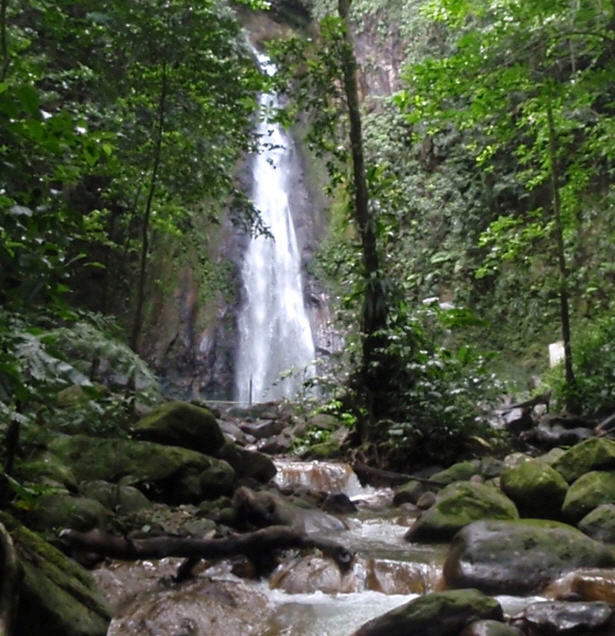
Not to be entirely negative about the tour, there were some positive aspects. Andy was a splendid guide. During the Syndicate Rainforest walk, he highlighted each type of tree, the specific time of month they were harvested, and what the wood was used for in Dominica. For example, some wood had unique application for the windward side of a home while others would be better suited for construction of the leeward side. ...
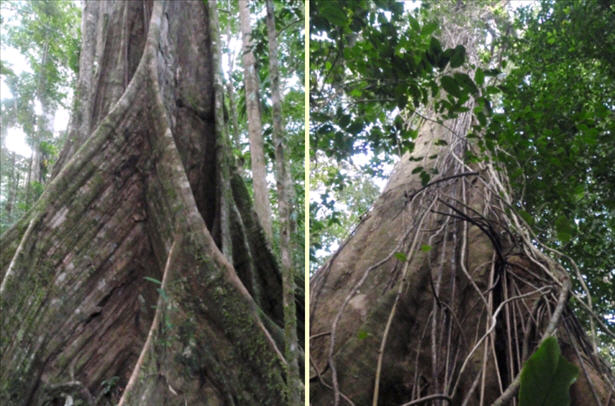
... On the way to the falls, he described and demonstrated how the people of Dominica literally live off the fruits of the land. We enjoyed fresh grapefruit plucked directly off the trees and sucked on sweet cocoa pods (the precursor for chocolate). ...

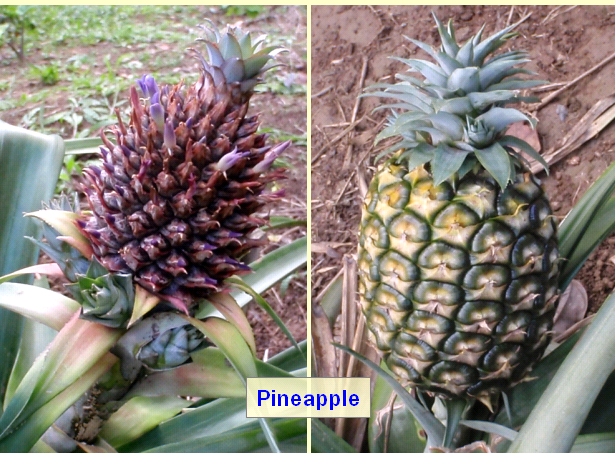
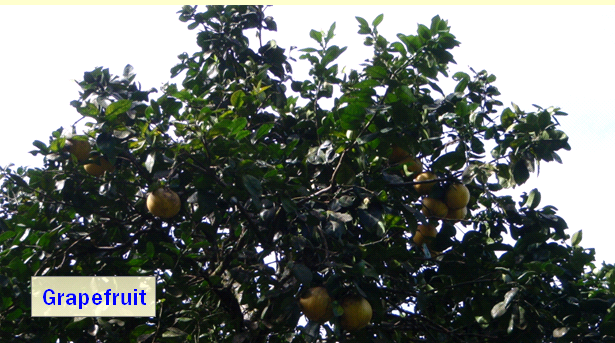
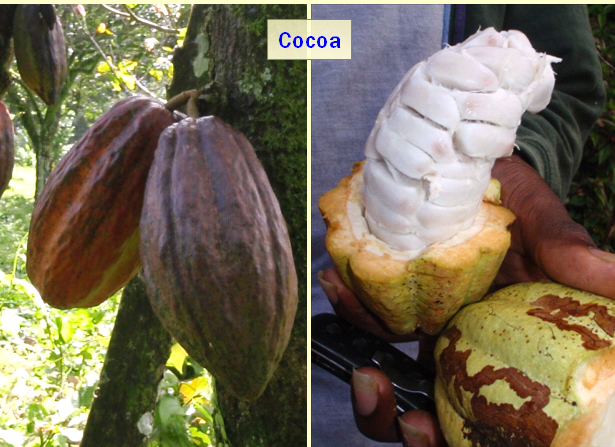
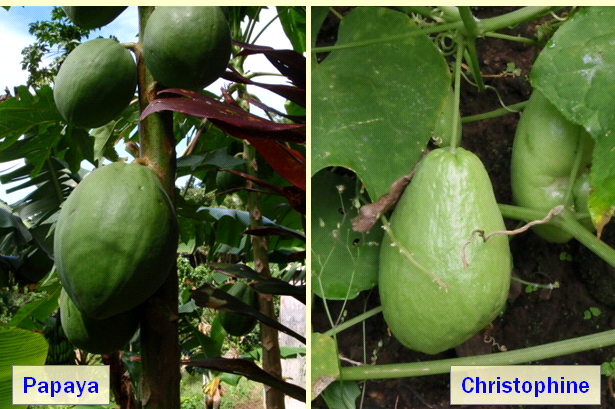


... And, of course, the natural beauty of this country simply cannot be denied. (GOOD)
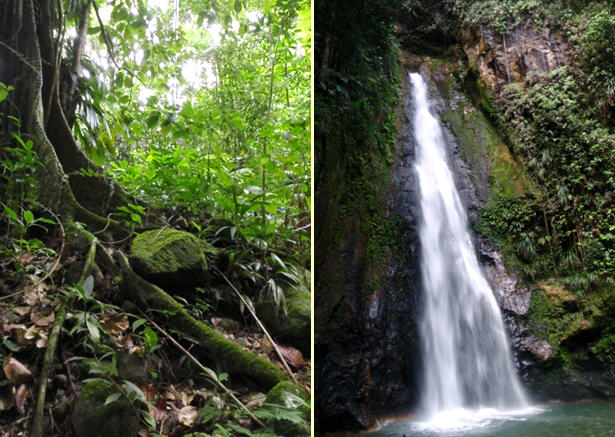

Unfortunately, we had been expecting that the tour would include a more rigorous hike up Morne Diablontin, one of the highest mountains in the eastern Caribbean. Therefore, in an effort to quell our disappointment and satisfy our need for physical exertion, we left the rest of our tour group as they boarded the water taxi back to their respective boats and told Alexis that we would meet him later for a ride home.
We walked down the road along the north end of the bay and entered Cabrits National Park. This cost another $5 per person, but we were free to explore on our own. In addition to Fort Shirley (a restoration project in process), the park boasts two small mountains, West Cabrit (623') and East Cabrit (458'). We hiked one trail up West Cabrit for some nice views of the bay ...

... and then a second trail up East Cabrit which afforded a view of portions of the fort which have yet to see any efforts at restoration. ...
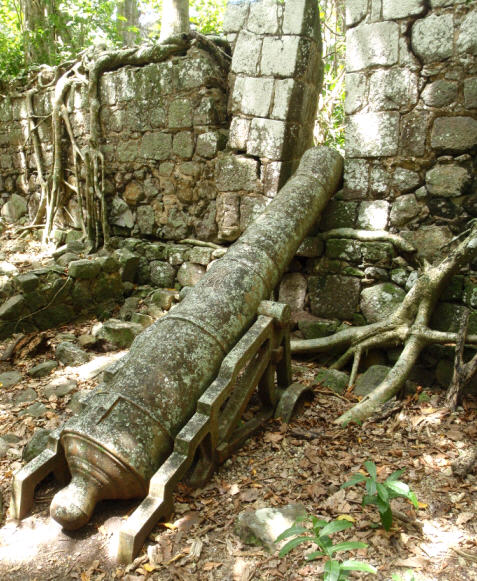
... I preferred the ambiance of the unrestored portions of the fort, as nature slowly but steadily reclaims what man had built. In the scattered light of the overhanging topical forest, it felt a little like being on the set of Jurassic Park. We saw lots of lizards but no dinosaurs. ...
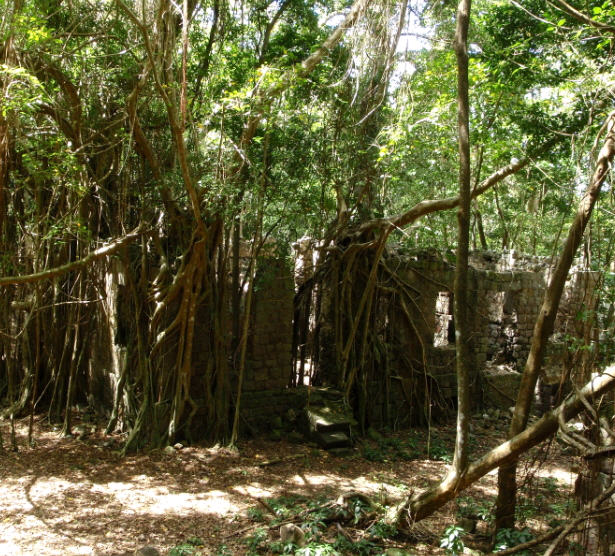
... With our hunger for exercise finally sated, we decided to treat ourselves to a late lunch ashore. Our pocketbook had already been pried open and abused for the day, so why not go for broke? We enjoyed a good meal and a few cold beers at Big Pappas, which is incredibly quiet during the daylight hours. Alexis arrived just as we were finishing up and shuttled us back to Prudence. (GOOD)
With consideration for the cost of land-based exploration (the major draw for our visit here in Dominica), we are planning to do only one more tour. The hike to the Boiling Lake, through the Valley of Desolation, is reputed to be one of the toughest hikes in Dominica. If all goes according to plan, we will leave the boat at first light tomorrow and not return until well after dark. Hopefully, tonight, we will have better luck at getting a good night's sleep.

15 34.671' N, 061 27.622' W
So far, we are enjoying our time in Dominica, but as with any place or circumstance there is both the GOOD and the BAD to consider:
Let's start with our anchorage. For the first two days we were here, the winds blew strong and gave us a good test of the set of our anchor. It passed the test with flying colors. On Day 1 I dove on the anchor, and on Day 2 Sheryl dove to the 20 ft mark and confirmed that the anchor was still solidly planted in the sand. The anchorage is incredibly large, so boats tend to keep their distance from one another. This allows us the additional comfort to have out excess scope. When anchoring with chain rode, the excepted minimum scope is 4:1. We dropped the anchor in 20 feet of water, and we always add 5 feet from the water line to the bow roller, so a 4:1 scope on 25 feet is 100 feet of rode. Here I felt comfortable letting out additional scope, especially since we plan to do a few days of land-based touring. We currently sit securely with 175 feet of chain in the water, a nice safe scope of 7:1, and a firmly set oversized anchor. (GOOD)
During those first two days the breeze through the boat was wonderful, the distance to shore kept any real chop from developing, and the anchorage seemed very well protected from any ocean swell. Conditions have changed over these last two days. The tradewinds moderated, and we are sitting in the wind shadow of some very high mountains. The calm has allowed the boat to drift around, and it invariably finds the swell. Whereas before our stern was pointed directly out to sea, we now lie beam-to the opening of the bay and the rolling motion has begun, once again. The motion was significant enough last night to send me to my lee-cloth cocoon in the salon. (BAD)
As an added potential hindrance to the goal of obtaining a good night's sleep, the people of Dominica like their nighttime music and they like it loud. Fortunately, on the first night of our arrival we discovered that we were just far enough away from Big Pappa's place to easily endure the background noise. It also helped that the winds were blowing strong and the now common noises generated as the wind moves through our rigging tended to further dampen the musical intrusion. We both said that this was nothing compared to the nocturnal auditory disturbances we had experienced while in Puerto Rico. (GOOD)
Last night the quality of the assault changed considerably. First, a second source of music was added to the mix. We are located closer to the 'disco' than to Big Pappa's. Last night, for the first time since our arrival, the disco was in full swing. Their musical selections alone would not have been too bad to listen to (mostly 70's music we knew all too well). However, these melodies were not alone. The reggae music generated from Big Pappa's mixed poorly with the disco tunes and created a discordant noise that made our ears wince. In addition, the calmer conditions allowed this cacophony to be delivered to us in crystal-clear high-fidelity sound. Finally, it should be noted that the common practice for nighttime music here appears to be as follows: Start the tunes at a modest volume around sunset, then turn the volume up one notch at the top of each hour, and continue this process until the volume dial reaches 11. The music, at maximum volume, then continues without break until 5AM. I wonder when these people sleep? (BAD)
I spend so much time discussing our conditions in the anchorage because that is where we have spent the bulk of our time. For a variety of reasons, we have elected not to inflate our dinghy here. We are well-stocked in the food and water departments, the two dinghy docks along the shore are both short and suffer from breaking swell, and we have reached a region of the Caribbean where it is prudent to lift your dinghy from the water each night (for security reasons). It is easier to simply leave little Patience stowed below. Fortunately, for us, any land-based needs we have can be coordinated through our Indian River Guide, Alexis. (GOOD)

The only disadvantage to being without our own tender is a slightly diminished social capacity. Recently, we have had several folks swing by and compliment the looks of our boat. Some are sailboat connoisseurs and can correctly identify it as a Southern Cross on sight, others inquire as to the make of our vessel. Another line of conversation is often opened by passersby who take note of our hailing port: Oriental, NC. We debated for some time when we were faced with the decision of selecting a hailing port. In our hearts we hail from Whortonsville, the place where we took the dream of cruising and converted it into a reality. Unfortunately, we probably would not have started nearly as many conversations with other cruisers had we listed our port as Whortonsville. Oriental is recognized by many due to its location along the ICW and its dedication to representing itself as the Sailing Capitol of North Carolina. In any case, our brief conversations with others as they pass by en route to anchor their boats is just that, brief. There isn't much chance for social follow-up when we are not taking our own dinghy to and from shore, which often opens the opportunity for the casual drop-by visits which often result in new friends. (BAD)
Yesterday, I finally stepped off the boat and onto land for the first time since Sunday. Alexis had approached us with the offer of coordinating a guided tour, and we accepted. The main goal of the tour was to see two parrot species which live only in Dominica, the sisserou and the jaco. In order to increase our chances of spotting these birds, we needed to get an early start. At 6AM, Alexis arrived to pick us up. Before we reached the dock Alexis had also gathered our still sleepy-eyed companions on this tour: Peter & Catharina (s/v Victoria W) and Geoffrey & Dave (s/v Anam Cara). We were delivered into the capable hands and minivan of our tour guide for the morning, Andy. One of the highlights of the day was the opportunity to socialize with others. (GOOD)

We bounced along in the minivan for about 20 minutes before reaching the Syndicate Rainforest. Once there, we took a leisurely stroll on a trail which was only about a mile long. No parrots were to be seen, although they taunted us with their calls from up high in the tree-tops. From there we climbed back into the van and made a short trip to the trail leading to Milton Falls. This trail led through someone's private land, then crossed a stream several times before arriving at the falls. While others in our tour were helped through each stream crossing by Andy, balancing precariously on slippery rocks in an effort to keep their shoes dry, Sheryl and I marched right through the water in our Keens (recommended footwear for any wet/dry outdoor experience). The falls turned out to be a bit disappointing. The natural spectacle was awe inspiring, as any waterfall tends to be; however, since the waterfall is a source of drinking water for villages below, a large fence (topped with barbed wire) had been erected around the pool at the waterfall's base in order to discourage swimming (Apparently the multiple signs indicating serious consequences for violating the no swim policy were not enough). It was an eyesore on an otherwise beautiful locale. Then it was back in the minivan for a bouncy ride back to the dock. The round-trip tour lasted less than 4 and a half hours. The cost to us was considerable: $40 per person for the water taxi ride, the minivan ride, and the guided tour; plus a $5 per person entry fee to the Syndicate Rainforest and a $2 per person fee to cross the private land to Milton Falls. That is over $100 US dollars out of our pocket in one morning, a considerable sum for two unemployed cruisers. (BAD)

Not to be entirely negative about the tour, there were some positive aspects. Andy was a splendid guide. During the Syndicate Rainforest walk, he highlighted each type of tree, the specific time of month they were harvested, and what the wood was used for in Dominica. For example, some wood had unique application for the windward side of a home while others would be better suited for construction of the leeward side. ...

... On the way to the falls, he described and demonstrated how the people of Dominica literally live off the fruits of the land. We enjoyed fresh grapefruit plucked directly off the trees and sucked on sweet cocoa pods (the precursor for chocolate). ...







... And, of course, the natural beauty of this country simply cannot be denied. (GOOD)


Unfortunately, we had been expecting that the tour would include a more rigorous hike up Morne Diablontin, one of the highest mountains in the eastern Caribbean. Therefore, in an effort to quell our disappointment and satisfy our need for physical exertion, we left the rest of our tour group as they boarded the water taxi back to their respective boats and told Alexis that we would meet him later for a ride home.
We walked down the road along the north end of the bay and entered Cabrits National Park. This cost another $5 per person, but we were free to explore on our own. In addition to Fort Shirley (a restoration project in process), the park boasts two small mountains, West Cabrit (623') and East Cabrit (458'). We hiked one trail up West Cabrit for some nice views of the bay ...

... and then a second trail up East Cabrit which afforded a view of portions of the fort which have yet to see any efforts at restoration. ...

... I preferred the ambiance of the unrestored portions of the fort, as nature slowly but steadily reclaims what man had built. In the scattered light of the overhanging topical forest, it felt a little like being on the set of Jurassic Park. We saw lots of lizards but no dinosaurs. ...

... With our hunger for exercise finally sated, we decided to treat ourselves to a late lunch ashore. Our pocketbook had already been pried open and abused for the day, so why not go for broke? We enjoyed a good meal and a few cold beers at Big Pappas, which is incredibly quiet during the daylight hours. Alexis arrived just as we were finishing up and shuttled us back to Prudence. (GOOD)
With consideration for the cost of land-based exploration (the major draw for our visit here in Dominica), we are planning to do only one more tour. The hike to the Boiling Lake, through the Valley of Desolation, is reputed to be one of the toughest hikes in Dominica. If all goes according to plan, we will leave the boat at first light tomorrow and not return until well after dark. Hopefully, tonight, we will have better luck at getting a good night's sleep.
| Vessel Name: | Prudence |
| About: |
Gallery not available

- PHOTOS:
- Dec 16, 2008 - May 21, 2009
- Mar 17, 2008 - Dec 15, 2008
- Nov 01, 2007 - Mar 16, 2008
- Our SC35 Sailboat: PRUDENCE
- SELECTED BLOGS
- Jan'05: The Idea
- May'05: First Cruise - Belize
- Aug'05: Buying Ashiya
- Oct'05: School in St. Vincent
- Nov'05: Ocracoke on Ashiya
- Jul'06: Long Trip on Ashiya
- Oct'06: Prudence Comes Home
- Nov'07: First Night Offshore
- Nov'07: Offshore Take Two
- Nov'07: Gulf Stream Crossing
- Dec'07: Green Turtle Cay
- Dec'07: Lynyard Cay
- Dec'07: Warderick Wells Cay
- Jan'08: George Town
- Jan'08: Life without a Fridge
- Jan'08: Mayaguana Island
- Jan'08: Turks & Caicos
- Jan'08: Dominican Republic
- Jan'08: Down the Waterfalls
- Feb'08: Puerto Rico
- Feb'08: Starter Troubles
- Feb'08: Vieques
- Mar'08: Finally Sailing Again
- Mar'08: Trip So Far
- Mar'08: Hiking Culebra
- Mar'08: Kayak & Snorkel I
- Mar'08: Teak and Waterspouts
- Mar'08: Kayak & Snorkel II
- Mar'08: Bottom Cleaning
- Apr'08: Culebra Social Life
- Apr'08: Culebra Routine
- Apr'08: Culebra Beaches
- Apr'08: Culebrita
- Jun'08: Kayak & Snorkel III
- Jun'08: Kayak & Snorkel IV
- Jun'08: Manta Ray
- Jun'08: Sea Turtles
- Jul'08: Cost of Cruising
- Jul'08: Busy Week in Culebra
- Jul'08: Getting to Land
- Jul'08: Leatherback Boil
- Jul'08: Fish and Volcano Dust
- Aug'08: Teaching Algebra
- Sep'08: Culebra Card Club
- Oct'08: Kayak & Snorkel V
- Oct'08: Prep for Hurricane
- Oct'08: Hurricane Omar
- Oct'08: Fish and Sea Glass
- Oct'08: Waterspouts
- Dec'08: Hurricane Season Ends
- Dec'08: Culebra to St. Martin
- Jan'09: Antigua Part 1
- Feb'09: The Saints
- Feb'09: Visiting Dominica
- Mar'09: Antigua Part 2
- Apr'09: Antigua to Bermuda
- May'09: Bermuda to Norfolk
- FULL LIST of Blog Entries





